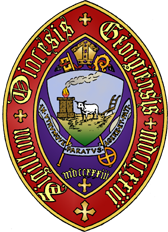1,700 Episcopalians packed the Aquarama on Jekyll Island in 1965 to take part in the closing Eucharist for a diocesan convention during which the Rt. Rev. Albert Rhett Stuart, commissioned twelve bishops to conduct the Bishops’ Crusade with each bishop in one city or town for five days. Bishop Stuart told the Savannah Evening Press, “The purpose of the Crusade is not to foster our Episcopalianism, but to bring the Gospel to the people of South Georgia.”
 To support the evangelistic effort, the diocese used roadside billboards, bumper stickers, posters, stacks of calling cards in motels, signs of every description, radio, TV, and newspaper advertising, and a diocesan-wide telephone campaign.
To support the evangelistic effort, the diocese used roadside billboards, bumper stickers, posters, stacks of calling cards in motels, signs of every description, radio, TV, and newspaper advertising, and a diocesan-wide telephone campaign.
In the week following the liturgy at the Aquarama, Central and South Georgia echoed with a dozen episcopal voices preaching the Gospel. An article in The Living Church said, “All of the bishops were presenting the facts about God’s love, explaining atonement and redemption, sin and repentance. Old-fashioned and basic. But the packaging of the messages, and the answers to questions, were purely twentieth-century. Humor and slang and good, clear, contemporary language were the media. At night the bishops addressed congregations in churches or auditoriums. By day they spoke to clubs, school and college assemblies, youth groups, ministerial alliances; appeared on radio and TV on panels and ‘meet-the-bishop’-type seminars; addressed workers in factories, knitting mills, and railroad yards.”
In sixty sermons and as many more formal and informal addresses to groups of all sizes, the bishops preached always stressing the Crusade theme, “because He loves us,” each told in his own way of that love and what it means. The Living Church added, “The bishops proved three points: (1) good preaching does happen in the Episcopal Church; (2) evangelism does go on in the Episcopal Church; and (3) the Gospel is still and yet Good News.”
 This evangelistic effort was the result of meticulous planning under one General Crusade Committee five subcommittees served, each dealing with a specific area: spiritual preparation, services, finance, promotion and publicity, and follow-up. Each of these had a counterpart in the twelve areas which were designated as preaching stations.
This evangelistic effort was the result of meticulous planning under one General Crusade Committee five subcommittees served, each dealing with a specific area: spiritual preparation, services, finance, promotion and publicity, and follow-up. Each of these had a counterpart in the twelve areas which were designated as preaching stations.
How successful was the crusade? St. Philip’s in Hinesville was founded as a direct result of the effort. Beyond this, the Episcopal Diocese of Georgia grew significantly during Bishop Stuart’s episcopacy. While it is easy to note that he served from 1954-1972, which was a prime time for church growth, the Diocese of Georgia’s rate of growth outpaced the growth of population in the state as well as the percentage growth of other denominations during this time. While this can not be shown as cause and effect from the Bishop’s Crusade. It should not be surprising that such a period of growth for Diocese did correlate with a bishop who put such sustained effort into spreading the love of God as found in Jesus.
 Bishop Harry Shipps held another Bishops’ Crusade in 1986. Twelve bishops from across the country were once again commissioned, this time by Presiding Bishop John M. Allin in a service at Christ Church in Savannah. They were sent to twelve parishes around the diocese for a three day preaching mission and interaction with parishioners. In January of 2018, Bishop Scott Benhase hosted a revival at Honey Creek. Presiding Bishop Michael Curry brought evangelical fervor to an immense revival tent on the grounds of the retreat center.
Bishop Harry Shipps held another Bishops’ Crusade in 1986. Twelve bishops from across the country were once again commissioned, this time by Presiding Bishop John M. Allin in a service at Christ Church in Savannah. They were sent to twelve parishes around the diocese for a three day preaching mission and interaction with parishioners. In January of 2018, Bishop Scott Benhase hosted a revival at Honey Creek. Presiding Bishop Michael Curry brought evangelical fervor to an immense revival tent on the grounds of the retreat center.
Pictured: Promotional materials and press coverage of the 1965 Bishops’ Crusade are shown in the photo at top. The chart in the middle shows the percentage growth from 1954 to 1967 with the Episcopal Diocese of Georgia’s percentage growth well beyond that of population growth. The bottom photo shows Presiding Bishop Michael Curry preaching at Honey Creek in 2018 as his Canon for Evangelism, the Rev. Canon Stephanie Spellers, looks on.
